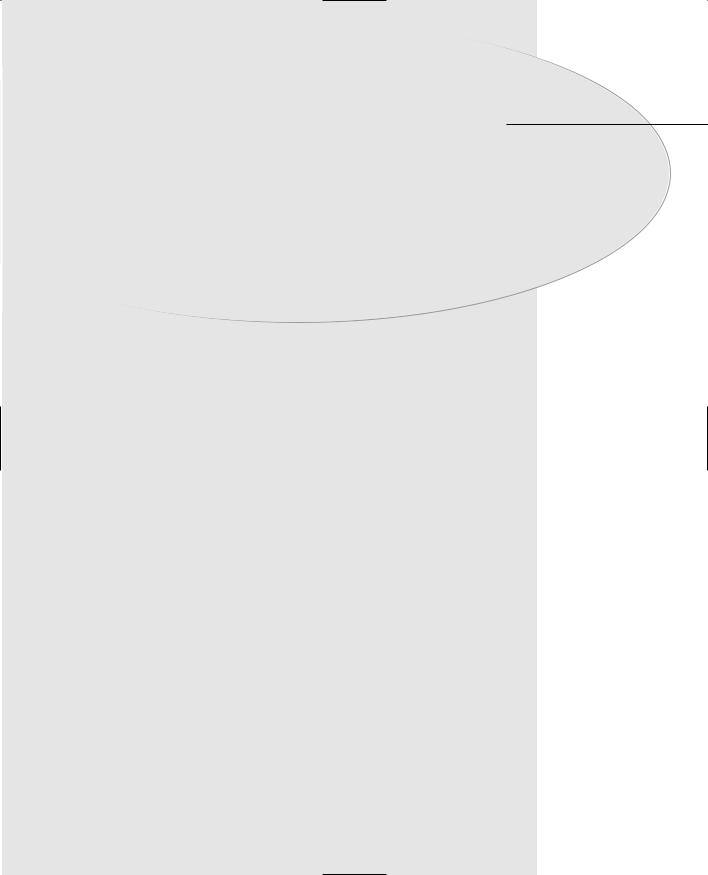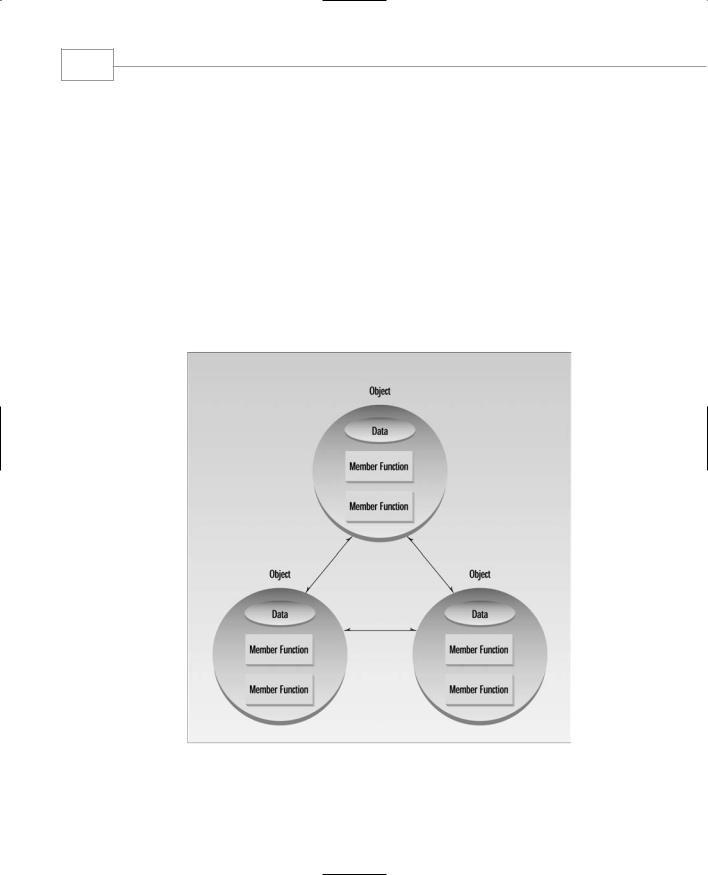
lafore_robert_objectoriented_programming_in_c
.pdf
5
INTRODUCTION
A Note to Teachers
Teachers, and others who already know something about C++ or C, may be interested in some details of the approach we use in this book and how it’s organized.
Standard C++
All the programs in this book are compatible with Standard C++, with a few minor exceptions that are needed to accommodate compiler quirks. We devote a chapter to the STL (Standard Template Library), which is included in Standard C++.
The Unified Modeling Language (UML)
In the previous edition, we introduced the UML in the final chapter. In this edition we have integrated the UML into the body of the book, introducing UML topics in appropriate places. For example, UML class diagrams are introduced where we first show different classes communicating, and generalization is covered in the chapter on inheritance.
Chapter 1, “The Big Picture,” includes a list showing where the various UML topics are introduced.
Software Development Processes
Formal software development processes are becoming an increasingly important aspect of programming. Also, students are frequently mystified by the process of designing an objectoriented program. For these reasons we include a chapter on software development processes, with an emphasis on object-oriented programming. In the last edition we focused on CRC cards, but the emphasis in software development has shifted more in the direction of use
case analysis, so we use that to analyze our programming projects.
C++ Is Not the Same as C
A few institutions still want their students to learn C before learning C++. In our view this is a mistake. C and C++ are entirely separate languages. It’s true that their syntax is similar, and C is actually a subset of C++. But the similarity is largely a historical accident. In fact, the basic approach in a C++ program is radically different from that in a C program.
C++ has overtaken C as the preferred language for serious software development. Thus we don’t believe it is necessary or advantageous to teach C before teaching C++. Students who don’t know C are saved the time and trouble of learning C and then learning C++, an inefficient approach. Students who already know C may be able to skim parts of some chapters, but they will find that a remarkable percentage of the material is new.

6
OBJECT-ORIENTED PROGRAMMING IN C++, FOURTH EDITION
Optimize Organization for OOP
We could have begun the book by teaching the procedural concepts common to C and C++, and moved on to the new OOP concepts once the procedural approach had been digested. That seemed counterproductive, however, because one of our goals is to begin true object-oriented programming as quickly as possible. Accordingly, we provide a minimum of procedural groundwork before getting to classes in Chapter 6. Even the initial chapters are heavily steeped in C++, as opposed to C, usage.
We introduce some concepts earlier than is traditional in books on C. For example, structures are a key feature for understanding C++ because classes are syntactically an extension of structures. For this reason, we introduce structures in Chapter 5 so that they will be familiar when we discuss classes.
Some concepts, such as pointers, are introduced later than in traditional C books. It’s not necessary to understand pointers to follow the essentials of OOP, and pointers are usually a stumbling block for C and C++ students. Therefore, we defer a discussion of pointers until the main concepts of OOP have been thoroughly digested.
Substitute Superior C++ Features
Some features of C have been superseded by new approaches in C++. For instance, the printf() and scanf() functions, input/output workhorses in C, are seldom used in C++ because cout and cin do a better job. Consequently, we leave out descriptions of these functions. Similarly, #define constants and macros in C have been largely superseded by the const qualifier and inline functions in C++, and need be mentioned only briefly.
Minimize Irrelevant Capabilities
Because the focus in this book is on object-oriented programming, we can leave out some features of C that are seldom used and are not particularly relevant to OOP. For instance, it isn’t necessary to understand the C bit-wise operators (used to operate on individual bits) to learn object-oriented programming. These and a few other features can be dropped from our discussion, or mentioned only briefly, with no loss in understanding of the major features of C++.
The result is a book that focuses on the fundamentals of OOP, moving the reader gently but briskly toward an understanding of new concepts and their application to real programming problems.

7
INTRODUCTION
Programming Exercises
No answers to the unstarred exercises are provided in this book. However, qualified instructors can obtain suggested solutions from the Sams Publishing Web site. Type the ISBN or title and click Search to move to this book’s page, then click Downloads.
The exercises vary considerably in their degree of difficulty. In each chapter the early exercises are fairly easy, while later ones are more challenging. Instructors will probably want to assign only those exercises suited to the level of a particular class.


The Big Picture
IN THIS CHAPTER
•Why Do We Need Object-Oriented Programming? 10
•Characteristics of Object-Oriented
|
Languages |
16 |
• C++ and C |
22 |
|
• |
Laying the Groundwork 23 |
|
• |
The Unified Modeling Language (UML) 23 |
|
CHAPT E R
1

Chapter 1
10
This book teaches you how to program in C++, a computer language that supports objectoriented programming (OOP). Why do we need OOP? What does it do that traditional languages such as C, Pascal, and BASIC don’t? What are the principles behind OOP? Two key concepts in OOP are objects and classes. What do these terms mean? What is the relationship between C++ and the older C language?
This chapter explores these questions and provides an overview of the features to be discussed in the balance of the book. What we say here will necessarily be rather general (although mercifully brief). If you find the discussion somewhat abstract, don’t worry. The concepts we mention here will come into focus as we demonstrate them in detail in subsequent chapters.
Why Do We Need Object-Oriented
Programming?
Object-oriented programming was developed because limitations were discovered in earlier approaches to programming. To appreciate what OOP does, we need to understand what these limitations are and how they arose from traditional programming languages.
Procedural Languages
C, Pascal, FORTRAN, and similar languages are procedural languages. That is, each statement in the language tells the computer to do something: Get some input, add these numbers, divide by six, display that output. A program in a procedural language is a list of instructions.
For very small programs, no other organizing principle (often called a paradigm) is needed. The programmer creates the list of instructions, and the computer carries them out.
Division into Functions
When programs become larger, a single list of instructions becomes unwieldy. Few programmers can comprehend a program of more than a few hundred statements unless it is broken down into smaller units. For this reason the function was adopted as a way to make programs more comprehensible to their human creators. (The term function is used in C++ and C. In other languages the same concept may be referred to as a subroutine, a subprogram, or a procedure.) A procedural program is divided into functions, and (ideally, at least) each function has a clearly defined purpose and a clearly defined interface to the other functions in the program.

The Big Picture |
11 |
|
The idea of breaking a program into functions can be further extended by grouping a number |
||
|
||
1 |
||
of functions together into a larger entity called a module (which is often a file), but the princi- |
||
|
||
ple is similar: a grouping of components that execute lists of instructions. |
|
|
Dividing a program into functions and modules is one of the cornerstones of structured pro- |
|
|
gramming, the somewhat loosely defined discipline that influenced programming organization |
|
|
for several decades before the advent of object-oriented programming. |
|
|
Problems with Structured Programming |
|
|
As programs grow ever larger and more complex, even the structured programming |
|
|
approach begins to show signs of strain. You may have heard about, or been involved |
|
|
in, horror stories of program development. The project is too complex, the schedule |
|
|
slips, more programmers are added, complexity increases, costs skyrocket, the sched- |
|
|
ule slips further, and disaster ensues. (See The Mythical Man-Month by Frederick P. |
|
|
Brooks, Jr. [Addison Wesley, 1982] for a vivid description of this process.) |
|
|
Analyzing the reasons for these failures reveals that there are weaknesses in the procedural |
|
|
paradigm itself. No matter how well the structured programming approach is implemented, |
|
|
large programs become excessively complex. |
|
|
What are the reasons for these problems with procedural languages? There are two related |
|
|
problems. First, functions have unrestricted access to global data. Second, unrelated functions |
|
|
and data, the basis of the procedural paradigm, provide a poor model of the real world. |
|
Let’s examine these problems in the context of an inventory program. One important global data item in such a program is the collection of items in the inventory. Various functions access this data to input a new item, display an item, modify an item, and so on.
THE
BIG
PICTURE
Unrestricted Access
In a procedural program, one written in C for example, there are two kinds of data. Local data is hidden inside a function, and is used exclusively by the function. In the inventory program a display function might use local data to remember which item it was displaying. Local data is closely related to its function and is safe from modification by other functions.
However, when two or more functions must access the same data—and this is true of the most important data in a program—then the data must be made global, as our collection of inventory items is. Global data can be accessed by any function in the program. (We ignore the issue of grouping functions into modules, which doesn’t materially affect our argument.) The arrangement of local and global variables in a procedural program is shown in Figure 1.1.

Chapter 1
12
FIGURE 1.1
Global and local variables.
In a large program, there are many functions and many global data items. The problem with the procedural paradigm is that this leads to an even larger number of potential connections between functions and data, as shown in Figure 1.2.
FIGURE 1.2
The procedural paradigm.
This large number of connections causes problems in several ways. First, it makes a program’s structure difficult to conceptualize. Second, it makes the program difficult to modify. A change made in a global data item may necessitate rewriting all the functions that access that item.

The Big Picture |
13 |
|
For example, in our inventory program, someone may decide that the product codes for the |
||
|
||
1 |
||
inventory items should be changed from 5 digits to 12 digits. This may necessitate a change |
||
|
||
from a short to a long data type. |
|
|
Now all the functions that operate on the data must be modified to deal with a long instead of |
|
|
a short. It’s similar to what happens when your local supermarket moves the bread from aisle |
|
|
4 to aisle 7. Everyone who patronizes the supermarket must then figure out where the bread |
|
|
has gone, and adjust their shopping habits accordingly. |
|
When data items are modified in a large program it may not be easy to tell which functions access the data, and even when you figure this out, modifications to the functions may cause them to work incorrectly with other global data items. Everything is related to everything else, so a modification anywhere has far-reaching, and often unintended, consequences.
THE
BIG
PICTURE
Real-World Modeling
The second—and more important—problem with the procedural paradigm is that its arrangement of separate data and functions does a poor job of modeling things in the real world. In the physical world we deal with objects such as people and cars. Such objects aren’t like data and they aren’t like functions. Complex real-world objects have both attributes and behavior.
Attributes
Examples of attributes (sometimes called characteristics) are, for people, eye color and job title; and, for cars, horsepower and number of doors. As it turns out, attributes in the real world are equivalent to data in a program: they have a certain specific values, such as blue (for eye color) or four (for the number of doors).
Behavior
Behavior is something a real-world object does in response to some stimulus. If you ask your boss for a raise, she will generally say yes or no. If you apply the brakes in a car, it will generally stop. Saying something and stopping are examples of behavior. Behavior is like a function: you call a function to do something (display the inventory, for example) and it does it.
So neither data nor functions, by themselves, model real-world objects effectively.
The Object-Oriented Approach
The fundamental idea behind object-oriented languages is to combine into a single unit both data and the functions that operate on that data. Such a unit is called an object.

Chapter 1
14
An object’s functions, called member functions in C++, typically provide the only way to access its data. If you want to read a data item in an object, you call a member function in the object. It will access the data and return the value to you. You can’t access the data directly. The data is hidden, so it is safe from accidental alteration. Data and its functions are said to be encapsulated into a single entity. Data encapsulation and data hiding are key terms in the description of object-oriented languages.
If you want to modify the data in an object, you know exactly what functions interact with it: the member functions in the object. No other functions can access the data. This simplifies writing, debugging, and maintaining the program.
A C++ program typically consists of a number of objects, which communicate with each other by calling one another’s member functions. The organization of a C++ program is shown in Figure 1.3.
FIGURE 1.3
The object-oriented paradigm.
